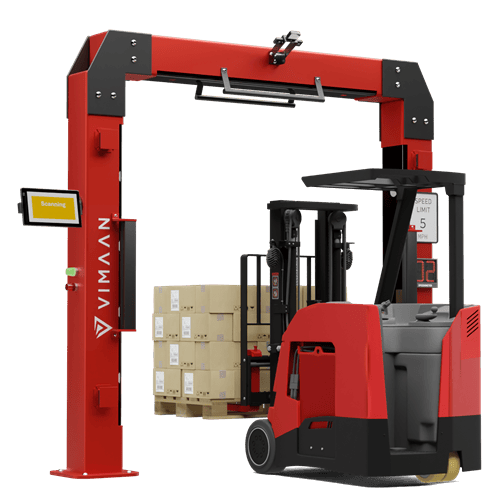4 Sided Pallet Scanning with PalletSCAN 360
Warehouses are capturing all 4 sides of pallets faster than ever before with PalletSCAN 360.
Your browser is out of date, for the best web viewing experience visit Browse Happy to upgrade your browser today.
Maximizing resources to ensure the highest productivity and output should be one of the top priorities for warehouse management. Every process of the inventory handling and management should be optimized to ensure swift and seamless operations. This involves measuring and recording dimensions accurately, a process vital for space utilization, transportation, and inventory management. However, this seemingly straightforward task is a significant labor challenge for warehouses.
Manual pallet dimensioning is labor-intensive and fraught with challenges due to the vast number daily pallets requiring measurement and the time required to accurately record. Compound these factors with labor shortages and human error, warehouses using pallet dimensioning automation are much more efficient than warehouses that do not.

Automated pallet dimensioning is a technological advancement designed to streamline and expedite the pallet dimensioning process. Pallet dimensioning leverages industrial hardware, software systems and advanced measurement technology such as lasers, depth sensing devices or computer vision. These technologies greatly diminish the need for human intervention, as some of the more advanced pallet dimensioning systems can dimension a pallet being transported from one area of the warehouse without stopping. A good example of this is PalletSCAN 3D, the Vimaan pallet dimensioning solution that measures pallets in motion.
Cycle counting is a critical process for all warehouses, but it’s extremely time-consuming and often results in shutting down aisles or complete areas of warehouses, interfering with picking and put-away events. Even with regimented cycle counting, warehouses and 3PLs still achieve sub-par inventory accuracy levels.
Warehouses have multiple types of technologies to consider when selecting their pallet dimensioning solution. Computer vision is now considered a superior alternative to lasers for pallet dimensioning due to its versatility, accuracy, and cost-effectiveness. Unlike lasers, which are limited by surface reflectivity (and complexity), computer vision systems like PalletSCAN 3D can analyze pallet dimension with few limitations.
Through advanced algorithms and image processing techniques, computer vision can accurately measure pallet dimensions with high precision, even in dynamic environments. Additionally, computer vision offers the flexibility to integrate seamlessly into existing workflows. For example, warehouses that use PalletSCAN 3D do not need to introduce new steps to their pallet dimensioning process. workers driving MHEs handling dimensions can simply pass under the computer vision system to accurately capture the measurements. This adaptability reduces implementation costs and minimizes disruptions to warehouse operations.
Another benefit to computer vision pallet dimensioning systems, is that solutions like PalletSCAN 3D can also equipped with label scanning, case counting and more. Additionally, computer vision allows you to seamlessly photograph pallets as they pass by.


Dimensioning pallets is essential for warehouses to optimize their storage space efficiently. By accurately measuring the dimensions of pallets, warehouses can ensure tht they utilize their available space effectively, minimizing wasted space and maximizing storage space utilization.
Dimensioning pallets is also crucial for ensuring warehouses are charged correctly by shippers for transportation and storage services. Many shipping companies base their fees on the size and volume of the cargo being transported or stored. Without accurate pallet dimensions, warehouse risk being overcharged or facing disputes with shippers regarding billing accuracy.
Automated pallet dimensioning is a major advamcnement in warehouse technlogy, offering a compelling solution to the labor challenges associated with manual dimensioning processes. By leveraging advanced scanning technlogies and software algorithms, warehouses streamline operations, iporve accurrac, and achiev greater efficienncy in pallet dimensioning, ultimzately driving overall producting and cost savings.
Now more than ever warehouses have options in pallet dimensioning technlogies. When considering these solutions consider the long-term viability of the solution and ways it can be combined with other tasks such as scanning, counting and digitally photographing pallets.

Delivering non-stop pallet dimensioning capabilities, PalletSCAN 3D computer vision cameras and sensors capture data automatically. Uninterrupted dimensioning allows forklift operators to keep moving and drive through without having to stop for manual pallet dimensioning.
Traditional inventory cycle counting processes are expensive, time consuming and are labor intensive. Download this 24-page resource to discover the inventory auditing practices that are helping leading warehouses reach their targeted inventory accuracy levels, while lowering headcount requirements and overall operational costs.
Warehouses are capturing all 4 sides of pallets faster than ever before with PalletSCAN 360.
Distributors reliably scan all outgoing cases in seconds ensuring customer orders are correct before shipping
ROS provides us with a competitive edge in delivering superior inventory tracking software.